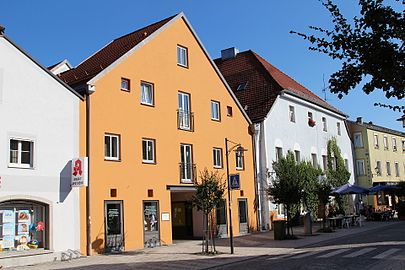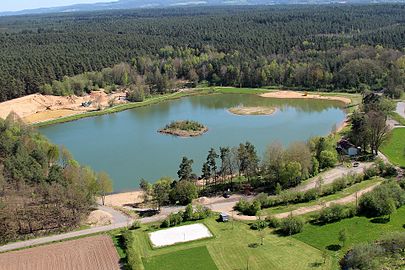Bruck in the Upper Palatinate
| coat of arms | Germany map | |
|---|---|---|

|
Coordinates: 49 ° 15 ' N , 12 ° 19' E |
|
| Basic data | ||
| State : | Bavaria | |
| Administrative region : | Upper Palatinate | |
| County : | Schwandorf | |
| Height : | 368 m above sea level NHN | |
| Area : | 44.4 km 2 | |
| Residents: | 4446 (Dec. 31, 2019) | |
| Population density : | 100 inhabitants per km 2 | |
| Postal code : | 92436 | |
| Area code : | 09434 | |
| License plate : | SAD, BUL , NAB , NEN, OVI, ROD | |
| Community key : | 09 3 76 117 | |
| LOCODE : | DE BBP | |
| Market structure: | 22 districts | |
Market administration address : |
Rathausstrasse 7 92436 Bruck idOPf. |
|
| Website : | ||
| Mayor : | Heike Faltermeier (CSU) | |
| Location of the market in Bruck idOpf. in the district of Schwandorf | ||
Bruck in der Oberpfalz (officially: Bruck idOPf. ) Is a market in the Upper Palatinate district of Schwandorf .
geography
Geographical location
Bruck is located in the Upper Bavarian Forest Nature Park in the Upper Palatinate , about 35 kilometers northeast of Regensburg on the federal highway 85 . Districts are Vorderthürn, Hinterthürn and Kellerhof, Sollbach with the former districts of Kobl, Wackenried, Ried, Gipfelberg and Sulzmühl, Schöngras with the former districts of Kölbldorf and Hofing, Mögendorf and Mappach. The Sulzbach, which arises in the Hammersee in Bodenwöhr and flows into the rain in Nittenau, flows through Bruck .
Community structure
The municipality of Bruck in the Upper Palatinate consists of the main town and the following 21 districts:
|
history
Until the church is planted
The place is first documented as Brugge around 1140 . Bruck becomes tangible as a market on April 25, 1343, because at that time Reymar the Younger von Schwarzenburg and his sister gave Bruck as a fief to the dukes of Upper Bavaria . that is, they placed themselves under their protection. Then Bruck appears again in a sales deed from June 19, 1345 of Ulrich von Satzenhofen , a brother-in-law of Reymar von Schwarzenburg, in which Bruck is sold to the Count Palatine Ruprecht the Elder and Ruprecht the Younger .
The neck court over the Bruck market was a fiefdom of the Landgraves von Leuchtenberg . Around 1396 they transferred this to Dietrich Hofer von Lobenstein . On May 3, 1470 the brothers Hans and Dietrich Hofer von Lobenstein ceded their rights in Bruck to Count Palatine Otto II . On May 15, 1468, he confirmed the old rights to the council and the community, in particular the right to hold a fair four times a year. In the letter of freedom and privilege awarded on July 12, 1489, the market was also granted the right to wall. Presumably this is related to the Hussite incursions since the beginning of the 15th century. However, the construction of the wall did not begin until after 1527 on the orders of the Count Palatine Friedrich , although it was also intended to deter vagabonds and rabble rousers. The erected wall was 15 feet high, had 12 half towers and three gates.
In the freedom letter of 1489, a distinction is made between lower jurisdiction , which was part of the self-administration of the market, and high criminal jurisdiction , which was exercised by the caretaker appointed by the sovereign . Another bailiff was provided as court, market and police servant . The nurse and bailiff also had the task of protecting the privileges of the market. These privileges were also confirmed by later sovereigns ( Elector Friedrich V from 1615, Elector Maximilian from 1628).
In the Thirty Years War Bruck was completely destroyed by the Swedes, which in the following period led to a high level of debt. Even in the trade tax cadastre from 1809, Joseph Anton von Destouches portrayed the economic situation of the market as extremely unfavorable. As a result of the Montgelas reforms, the self-government of the market was further restricted and the lower jurisdiction exercised by the market was completely abolished in 1808. The edict of 1818 gave the market back its self-government in a limited form.
District affiliation
With effect from July 1, 1972, Bruck came to the district of Schwandorf.
Incorporations
In 1945 or 1946, the previously independent communities of Mappach, Mögendorf and Vorderthürn were incorporated. On July 1, 1971, Schöngras and Sollbach were added. On November 1, 2013, a piece of the dissolved community-free area Einsiedler and Walderbacher Forst was added. On January 1, 2017, part of the former community-free area of Eastern Neubäuer Forest was incorporated.
Population development
Between 1988 and 2018 the market grew from 4,093 to 4,462 by 369 inhabitants or 9%.
politics
(2008: 62.3%)
Market council
The local elections on March 16, 2014 resulted in the following distribution of seats:
| SPD | Green | FW | CSU |
|---|---|---|---|
| 3 seats | 2 seats | 6 seats | 6 seats |
mayor
The mayoral election on January 11, 2009 led to the following result:
- Hans Frankl (FW): 43.87%
- Robert Feuerer (CSU): 38.47%
- Helmut Faltermeier (SPD): 13.72%
- Rudi Sommer (GREEN): 3.93%
The two strongest candidates competed against each other in a runoff election on January 25, 2009, which Hans Frankl (FW) won with 53.29% of the vote against Robert Feuerer (CSU), who scored 46.71%. Frankl was confirmed in office in 2014.
coat of arms
Blazon: In blue over silver waves a golden wooden bridge on which a red crowned and red armored golden lion strides. Coat of arms since the end of the 15th century. The Palatinate Bavarian lion reminds of the local rule of the Wittelsbacher.
Twin cities
Sister cities are:
- Seiffen in the Ore Mountains (since 1991)
- Malesherbes , France (since 1996)
- Ober-Olm , Rhineland-Palatinate
- Bobrowice , Poland
traffic
Street
Bruck is connected to the motorway network by the federal motorway 93 , which is 15 kilometers away (coming from the south: junction Teublitz (35); coming from the north: junction Schwandorf Mitte (33) in the direction of Cham - federal road 85 ). The well-developed B 85 runs directly north of the market town and is also called the Bayerwaldautobahn in the region because of its four-lane route . The dual carriageway trunk road 16 , which leads directly to Regensburg can be reached in less than seven kilometers away in neighboring Nittenau.
rail
There is a train station in the neighboring municipality of Bodenwöhr. The train service is guaranteed by the Upper Palatinate Railway. The line runs from Schwandorf to Furth im Wald via Bodenwöhr-Nord, Roding and Cham. Between 1907 and 1955 there was a stop on the Bodenwöhr – Nittenau railway line . Today this railway line is only used by freight trains.
aviation
The Nittenau-Bruck airfield has the ICAO code EDNM and is located between the two villages of Nittenau and Bruck.
Danube-Vltava Railway Initiative
The City of Regensburg, together with other East Bavarian municipalities and institutions, has taken a number of measures to improve the rail infrastructure in East Bavaria in recent years . A new line is to be built between Regensburg and Pilsen, on which the long-distance trains will run from Munich to Prague. Should the project be implemented, it is likely that Bruck-Schöngras and Nittenau will get a train station on this new rail route.
Sports
The Bruck game association was founded in 1925. The club colors are black and white. Football, ladies' gymnastics, stick shooting, children's floor exercise, basketball, men's gymnastics, skiing, chess, taekwondo, tennis and volleyball are offered.
Attractions
- Remains of the market fortifications, half towers from 1489
- Mappach Local History and Farming Museum
- Pilgrimage Church of St. Sebastian
- Catholic parish church of St. Giles
- Sulzbach sand oasis
nature
Festivals
- Citizens' festival every year in July
- Christmas Market
Personalities
- Franz Xaver Krautbauer (1824–1885), Catholic bishop of Green Bay , USA, born in the Mappach district
- Emilia Müller , politician, resident in Bruck, Minister in the Stoiber IV , Seehofer I and Seehofer II cabinets .
literature
- Luybl, Christoph . In: Hans Vollmer (Hrsg.): General lexicon of fine artists from antiquity to the present . Founded by Ulrich Thieme and Felix Becker . tape 23 : Leitenstorfer – Mander . EA Seemann, Leipzig 1929, p. 487 .
- Ingrid Schmitz-Pesch: Roding. The care offices Wetterfeld and Bruck (= Historical Atlas of Bavaria, part of Altbayern Heft 44). Commission for Bavarian History, Verlag Michael Lassleben, Munich 1986. ISBN 3-7696-9907-6 .
Web links
- Local government
- Aerial photos of the market on oberpfalz-luftbild.de
- Danube-Vltava Railway Initiative
- Bruck in der Oberpfalz: Official statistics of the LfStat
Individual evidence
- ↑ "Data 2" sheet, Statistical Report A1200C 202041 Population of the municipalities, districts and administrative districts 1st quarter 2020 (population based on the 2011 census) ( help ).
- ↑ bayerische-landesbibliothek-online.de
- ↑ Ingrid Schmitz-Pesch, 1986, especially p. 414 ff.
- ^ Wilhelm Volkert (ed.): Handbook of Bavarian offices, communities and courts 1799–1980 . CH Beck, Munich 1983, ISBN 3-406-09669-7 , p. 559 .
- ↑ Announcement (PDF).
- ^ Government of Upper Palatinate: Official Gazette, No. 12, 2016
- ↑ wahlen.bayern.de Bavarian State Office for Statistics
- ↑ marktbruck.de
- ↑ marktbruck.de
- ↑ Mittelbayerische.de
- ↑ marktbruck.de
- ↑ http://www.mittelbayerische.de/index.cfm?pid=3077&pk=349324&p=1 ( page no longer available , search in web archives ) Info: The link was automatically marked as defective. Please check the link according to the instructions and then remove this notice.
- ↑ according to source www.wahlen.landkreis-schwandorf.de, accessed on November 25, 2019
- ↑ marktbruck.de
- ^ Entry on the coat of arms of Bruck in the Upper Palatinate in the database of the House of Bavarian History
- ↑ market Bruck: Sister Cities Accessed on May 23, 2011th










